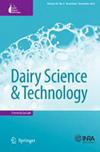利用动物个体能量平衡平衡产奶量
Q2 Agricultural and Biological Sciences
引用次数: 3
摘要
传统上,奶牛的能量供应是基于牛群的平均生产性能。由于这与个体动物之间需求的巨大差异相矛盾,本研究的目的是量化用于计算个体动物能量平衡(EB)的相关子变量的变化程度和后果。研究了28头产犊德国荷斯坦奶牛在产犊后第2 ~ 15周饲喂7.0 MJ NEL TMR的总能量供应(TES)和需水量(TER)。TES主要受DMI影响,从100.1 MJ NEL/d(第2周)增加到152.1 MJ NEL/d(第15周);P < 0.01)。周变异系数(CV)在0.10 ~ 0.16之间,与DMI的CV相似(0.09 ~ 0.17)。维持(体重)和生产(产奶量)所需能量的总和TER从174.8 MJ NEL/d(第2周)降至164.5 MJ NEL/d(第15周);p < 0.01), CV在0.16(第2周)~ 0.07(第11周)之间变化。EB从−74.8 MJ NEL/d(第2周)增加到−12.4 MJ NEL/d(第15周);p < 0.01), CV从0.32(第3周)到1.01(第10周)不等。结果表明,以单个动物为基础计算EB是识别无法应对其能量状况风险增加的动物的先决条件,这种风险会导致失败成本,从而耗尽受影响奶牛的利润。本文章由计算机程序翻译,如有差异,请以英文原文为准。
Balancing Trade-Offs in Milk Production by Making Use of Animal Individual Energy Balancing
Traditionally, the energy supply of dairy cows is based on the average performance of the herd. Because this contradicts the great variation in requirements between individual animals, the objective of the present study was to quantify both the extent and consequences of variation in the relevant sub-variables used to calculate the energy balance (EB) on an individual animal basis. Total energy supply (TES) and requirements (TER) of 28 multiparous German Holstein dairy cows fed TMR with 7.0 MJ NEL were studied between the 2nd and 15th week after calving. TES, mainly influenced by DMI, increased from 100.1 (week 2) to 152.1 MJ NEL/d (week 15; p < 0.01). Weekly coefficients of variation (CV) ranged between 0.10 and 0.16 and were similar to the CV of DMI (0.09 to 0.17). TER, as the sum of energy requirement for maintenance (body weight) and production (milk yield), decreased from 174.8 (week 2) to 164.5 MJ NEL/d (week 15; p < 0.01) and CV varied between 0.16 (week 2) and 0.07 (week 11). EB increased from −74.8 (week 2) to −12.4 MJ NEL/d (week 15; p < 0.01) and CV varied from 0.32 (week 3) to 1.01 (week 10). The results indicate that calculating EB on an individual animal basis is a prerequisite to identify animals with an increased risk of failing to cope with their energy situation, which cause failure costs that drain the profit of affected cows.
求助全文
通过发布文献求助,成功后即可免费获取论文全文。
去求助
来源期刊

Dairy Science & Technology
农林科学-食品科技
CiteScore
2.30
自引率
0.00%
发文量
0
审稿时长
2 months
期刊介绍:
Information not localized
 求助内容:
求助内容: 应助结果提醒方式:
应助结果提醒方式:


